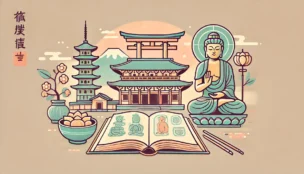
Cultural prosperity of the Nara Period and its background(奈良時代の文化的繁栄とその背景)
During the Nara period, a centralized national system was established, and a sophisticated aristocratic culture centered on Heijō-kyō(平城京) flourished, based on the wealth gathered from all over the country. The culture of this period developed most during the reign of Emperor Shōmu(聖武天皇) in the 8th century, and is known as the “Tempyō culture(天平文化)” after the era name. The Tempyō culture was strongly influenced by the culture of the Tang Dynasty(唐), which was introduced to Japan via the Kentōshi envoys(the Japanese envoys to the Tang Dynasty 遣唐使), and was rich in international flavor and glamour.
Heijō-kyō and the influence of Tang culture(平城京と唐文化の影響)
At the time, Chang’an(長安), the capital of the Tang Dynasty, was a prosperous international city linked to Central Asia, Persia, the Mediterranean, India and other regions via the Silk Road, and its cultural and economic influence reached Japan. As a result of the direct introduction of advanced Tang culture by the Kentōshi envoys, the Tenpyō culture was characterized by its fusion with foreign cultures. In particular, the Shōsoin(正倉院) at Tōdaiji Temple(東大寺) preserves items related to Emperor Shōmu, including imported goods and Japanese-made crafts. These objects show that the level of technology greatly improved, inspired by foreign cultures.
Development of art and sculpture(美術と彫刻の発展)
In Nara period art, new techniques were introduced in Buddhist statue carving. In addition to the traditional wooden and gilt-bronze statues, innovative techniques such as sozō(clay statues 塑像) and kanshitsuzō(dry lacquered statues 乾漆像) were used, and many works were created that were highly realistic and sought to capture reality. These sculptures not only expressed Buddhist thought, but also clearly showed the high level of technology at the time.
Development of Literature(文学の発展)
In the field of literature, both Waka (Japanese poetry 和歌) and Chinese literature(漢文学) developed.
Wka was written by a wide range of people, from the emperor to the common people, and the Manyōshū (Ten Thousand Leaves 万葉集) contains around 4,500 poems written up to 759. It is also distinctive in that it uses the Manyo kana(万葉仮名) system of Japanese notation, which was used at the time.
Meanwhile, Chinese literature was valued as an important part of the education of government officials, and in 751 the Kaifūsō(Fond Rcollections of Poetry 懐風藻) was compiled. Literary figures such as Ōmi no Mifune(淡海三船) and Issonokami no Yakatsugu(石上宅嗣) were also active, and Issonokami no Yakatsugu established the Untei(芸亭) which made his library available to the public to promote learning.
Compilation of national histories and development of geographical surveys(国史の編纂と地誌の整備)
With the establishment of the Ritsuryō system(律令制度), the compilation of national histories and geographical surveys was promoted by the government.
In 712, the Kojiki(Records of Ancient Matters 古事記) was completed, and in 720, the Nihon Shoki(Chronicles of Japan 日本書紀) was completed. These were records of the history of the Imperial Family and the nation.
The Kojiki was written by Ō no Yasumaro(太安万侶) based on the Teiki(帝紀) and Kyūji(旧辞), which were read to him by Hieda no Are(稗田阿礼), and it shows the ingenuity of using foreign kanji to write Japanese.
On the other hand, the Nihon Shoki was written in a Chinese style that imitated the Chinese chronological style, and it records the history of Japan from the age of the gods to the reign of Empress Jitō(持統天皇).
After the Nihon Shoki, the six national histories of the Heian period, such as the Shoku Nihongi(続日本紀), Nihon Kouki(日本後紀, Shoku Nihon Kouki(続日本後紀), Nihon Montoku Tennō Jitsuroku(日本文徳天皇実録), and Nihon Sandai Jitsuroku(日本三代実録), were compiled, and the historical records of Japan were continuously improved.
In addition, in 713, the provinces were ordered to report on their geography, products and folklore, and these records were compiled as Fudoki(provincial gazetter 風土記). The extant Fudoki are those for the five provinces of Hitachi(常陸), Izumo(出雲), Harima(播磨), Bungo(豊後) and Hizen(肥前), and only those for the Izumo Province have survived in their entirety.
Development of educational institutions(教育機関の整備)
In order to train government officials, Daigaku(royal academy 大学) were established in the capital and Kokugaku(provincial academies 国学) were set up in the provinces.
At the Daigaku, the children of nobles and clan leaders studied Confucian scriptures, the Ritsuryō legal code, arithmetic and other subjects, while the children of county administrators received their education at Kokugaku in the provinces. In the 9th century, the Kiden-dō(紀伝道), where students studied history and Chinese classics, also appeared, and specialist knowledge such as that of the Yin-Yang theory(陰陽道) and medicine was also taught.